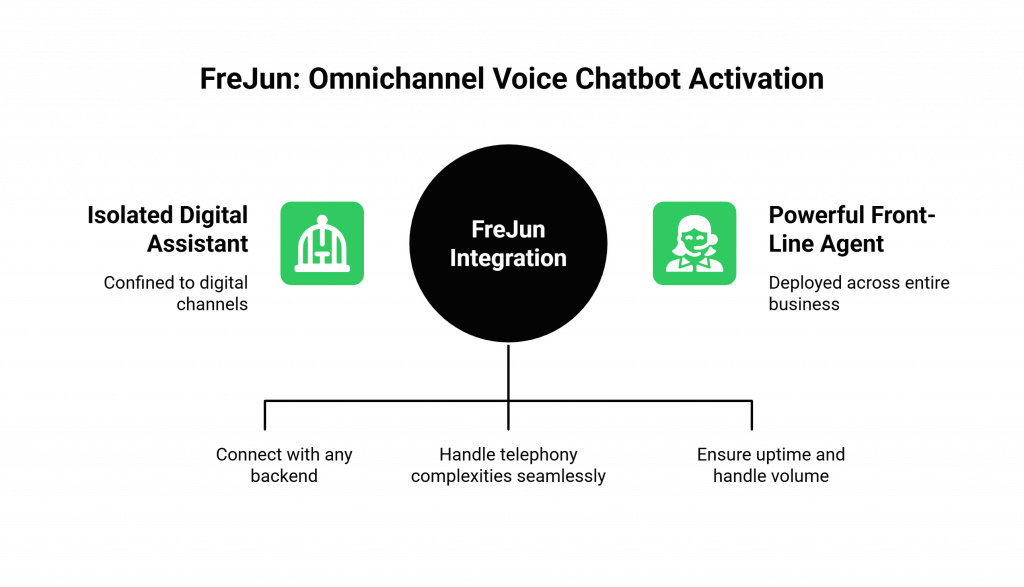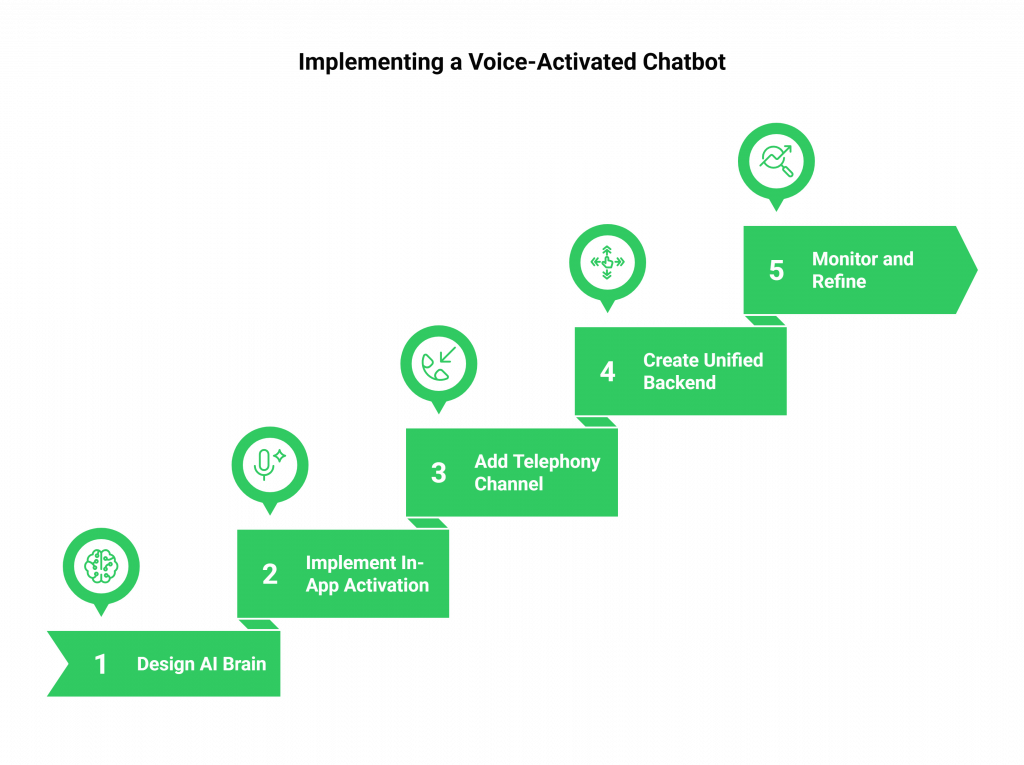The way users interact with software has fundamentally changed. The era of silent, text-based chatbots is giving way to a more natural and intuitive paradigm: the voice-activated conversation. Implementing Voice chatbot activation is no longer a futuristic novelty; it’s a strategic imperative for any business looking to provide a truly hands-free, accessible, and engaging user experience. The promise is a seamless interface where users can simply speak to get what they need, anytime, anywhere.
Table of contents
- What is Voice Chatbot Activation?
- The Implementation Trap: A Voice That’s Trapped Online
- FreJun: The Infrastructure for True Omnichannel Activation
- In-App Activation vs. A True Omnichannel Voice Strategy: A Comparison
- A Full Guide to Implementing a Complete Voice-Activated Chatbot
- Best Practices for a Flawless Voice Chatbot Activation
- Final Thoughts: Your Chatbot is Smart. Make Sure It Can Answer the Call
- Frequently Asked Questions (FAQ)
With a rich ecosystem of AI platforms and APIs, the technical path to building a voice-activated bot has never been clearer. However, a critical and costly blind spot exists in many implementation strategies. A brilliant bot that can be activated by a user within your digital walls is a powerful tool, but it’s an incomplete solution. The real challenge lies in making that same bot accessible on the one channel that often matters most for high-stakes interactions: the telephone.
What is Voice Chatbot Activation?
Voice chatbot activation is the process that enables a conversational AI to start, respond to, and execute tasks based on a user’s spoken input. It’s the “on switch” for a hands-free dialogue. This is typically achieved in one of two ways in a digital environment:
- Explicit Activation: The user performs a clear action, like tapping a microphone icon on a screen (“tap-to-talk”).
- Wake Word Activation: The system continuously listens for a specific “hotword” (e.g., “Hey, Bot”) that triggers it to start processing the user’s speech.
Under the hood, this process runs on a sophisticated real-time pipeline of technologies: Automatic Speech Recognition (ASR) transcribes speech, Natural Language Understanding (NLU) deciphers intent, Dialog Management tracks the conversation, and Text-to-Speech (TTS) generates the spoken response.
The Implementation Trap: A Voice That’s Trapped Online
Modern frameworks and APIs from Google, IBM, and OpenAI have made it remarkably easy to build the “brain” of a voice-activated chatbot and deploy it within a web or mobile application. The in-app experience can be seamless and powerful.
But what happens when your highest-value enterprise client has a critical service outage and their first instinct isn’t to navigate your website, but to call your support hotline? What about a less tech-savvy user who finds it far easier to dial a number than to use an app?
At this moment, your brilliant in-app assistant is completely unreachable. This is the implementation trap. The platforms and protocols that handle microphone input from a browser exceptionally well do not support direct integration with the Public Switched Telephone Network (PSTN). A phone call is, in itself, an act of Voice chatbot activation, but the infrastructure required to handle it is a completely different world. To bridge this gap, you would need to build a highly specialized telephony stack from scratch, a massive technical distraction and a significant financial investment.
FreJun: The Infrastructure for True Omnichannel Activation
This is the exact problem FreJun was built to solve. We are not another AI platform. We are the specialized voice infrastructure layer that connects the intelligent chatbot you’ve already built to the global telephone network.

FreJun provides a simple, developer-first API that handles all the complexities of telephony, allowing you to create a truly seamless, omnichannel experience. We provide the missing piece for a complete Voice chatbot activation strategy.
- We are AI-Agnostic: You bring your own bot’s “brain.” FreJun integrates with any backend, whether it’s powered by Dialogflow, Rasa, or a custom stack of APIs.
- We Manage the Voice Infrastructure: We handle the phone numbers, the SIP trunks, the real-time media servers, and the low-latency audio streaming.
- We Guarantee Reliability and Scale: Our globally distributed, enterprise-grade platform ensures your phone line is always online and ready to handle high call volumes.
With FreJun, you can finally break your assistant out of its digital cage and deploy it as a powerful front-line agent for your entire business.
Key Takeaway
A successful Voice chatbot activation strategy must be omnichannel. While in-app activation is a powerful feature for digital users, it fails to serve customers who prefer or need to call. FreJun provides the essential voice infrastructure that bridges this gap, connecting your AI to the telephone network and transforming it from a helpful widget into a powerful, always-available business asset.
In-App Activation vs. A True Omnichannel Voice Strategy: A Comparison
| Feature | In-App Voice Chatbot Activation | An Omnichannel Voice Strategy (with FreJun) |
| Accessibility | Limited to users on your website or in your app. | Universally accessible to anyone with a phone, plus all digital channels. |
| Use Cases | On-site guidance, in-app feature help. | 24/7 call centers, virtual receptionists, automated phone orders, critical incident support. |
| Business Impact | A modern UX feature that improves digital engagement. | A strategic asset that reduces operational costs and serves all customer segments. |
| Infrastructure Burden | Low. Managed by the AI platform’s SDKs. | Zero telephony infrastructure to build. FreJun manages the entire voice stack. |
| Customer Journey | Fragmented. A user must switch from a call to your web app to get automated help. | Unified. A user can interact with the same intelligent assistant across all channels. |
A Full Guide to Implementing a Complete Voice-Activated Chatbot
This step-by-step guide outlines the modern architecture for creating a voice assistant that works both inside your digital platforms and over the phone.

Step 1: Design and Build Your Centralized AI “Brain”
First, use your chosen platform (like Dialogflow, Rasa, or a custom stack of APIs) to design the core conversational logic of your chatbot. This “brain” will handle intent recognition, dialogue management, and context tracking. It should be designed as a channel-agnostic service.
Step 2: Implement In-App Voice Activation
For your web and mobile applications, integrate the necessary SDKs or browser APIs to handle client-side Voice chatbot activation. This will involve requesting microphone permissions and implementing a clear trigger, like a tap-to-talk button. This client will stream audio to your backend, which then communicates with your AI “brain.”
Step 3: Add the Telephony Activation Channel with FreJun’s API
This is the critical step that makes your bot truly omnichannel.
- Sign up for FreJun and instantly provision a virtual phone number.
- Use FreJun’s server-side SDK in your backend to handle incoming WebSocket connections from our platform.
- In the FreJun dashboard, configure your new number’s webhook to point to your backend’s API endpoint.
Step 4: Create a Unified Backend to Route Requests
Your backend application will now act as a central hub.
- When a request comes from your web/mobile app, it will pass the audio to your STT service and then to your AI “brain.”
- When a call comes in via FreJun, your backend receives the raw audio stream. It will then orchestrate the exact same pipeline: STT -> AI “Brain” -> TTS.
This unified backend ensures the same intelligent core is powering every conversation, regardless of the channel.
Step 5: Monitor and Refine Your Omnichannel Experience
Use a unified analytics dashboard to track bot performance, resolution rates, and user satisfaction across your website, app, and phone line. This provides a holistic view of your customer experience and highlights areas for improvement in your Voice chatbot activation flows.
Best Practices for a Flawless Voice Chatbot Activation
- Prioritize Privacy with Explicit Triggers: Whether in-app or on the phone, the conversation should only begin with a clear user action. For apps, use a tap-to-talk button. For the phone, the act of calling is the trigger. Avoid “always-on” listening.
- Optimize for Low Latency: A natural conversation requires a response time of under one second. This means optimizing your entire pipeline, from ASR transcription to TTS synthesis.
- Provide Clear UI/UX Cues: In your app, visually indicate when the bot is listening, thinking, or speaking. This manages user expectations and improves the experience.
- Design for Graceful Failure: No AI is perfect. Design a clear fallback path to a human agent for moments when the bot gets stuck. Use FreJun’s API to enable seamless call transfers, ensuring the customer always receives support.
Final Thoughts: Your Chatbot is Smart. Make Sure It Can Answer the Call
You have invested in building an intelligent, helpful, and engaging chatbot. You’ve given it the power of voice. Now, it’s time to ensure that voice can be heard everywhere. A successful Voice chatbot activation strategy is not just about the technology; it’s about accessibility.
By limiting your bot’s reach to your digital properties, you are leaving your most direct and often most critical communication channel unprotected. The strategic path forward is to combine the best in-app tools with a robust voice infrastructure partner. FreJun provides the simple, powerful, and reliable API that bridges the gap between your application and the telephone network.
Don’t just build a bot that can talk. Build a bot that can answer the call.
Further Reading – Build a Conversational AI Voice Bot from Backend APIs
Frequently Asked Questions (FAQ)
No, it complements them. You use those platforms to build the AI “brain” of your chatbot. FreJun provides the separate, essential infrastructure to connect that brain to the telephone network, enabling a complete Voice chatbot activation on that channel.
Yes, and this is the recommended approach. A unified backend that houses your core AI logic ensures a consistent experience and is far more efficient to maintain.
We offer developer-first SDKs and a simple API. If your team can work with a standard backend framework and a WebSocket connection, you have all the skills needed to integrate FreJun. We abstract away all the telecom complexity.
FreJun is designed for the telephony channel, where the “wake word” is effectively the act of the customer dialing your number and the call being answered. The session is activated the moment the call connects. This is the most natural form of Voice chatbot activation for the telephone.
This architecture is highly scalable. FreJun’s infrastructure is built to handle massive call concurrency. By designing your backend to be stateless, you can use standard cloud auto-scaling to handle traffic from all your channels, ensuring your service is both resilient and cost-effective.
